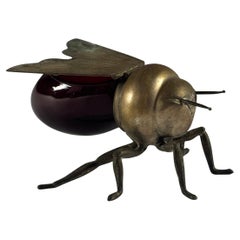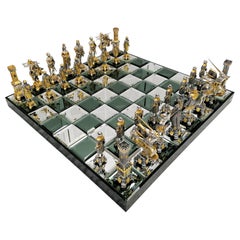The Home Bothy Sheffield and Silverplate
to
1
1
1
1
1
1
1
1
1
1
1
1
1
1
Early 20th Century Honey Jar in the Form of a Bee
Located in Pease pottage, West Sussex
Early 20th Century Honey Pot in the Form of a Bee, silver plate head, wings and legs, Red glass body. Tarnished and patinated. Possibly Mappin & Webb Circa 1930.
Category
Early 20th Century English Sheffield and Silverplate
Materials
Silver Plate
Related Items
Italian silver plated shell-form sweetmeat dish, Franco Lapini, 20th
By Franco Lapini
Located in Paris, FR
Elegant silver-plated platter by Franco Lapini, featuring six finely sculpted shells supported by an intertwined fish composition. This exceptional piece perfectly combines elegance ...
Category
20th Century Italian Platters and Serveware
Materials
Silver Plate
20th Century Sculptural Italian Chess Game
By Arval Argenti Valenza
Located in VALENZA, IT
Brass chess board and chess game made with the ancient casting technique.
After casting, the finish was chiseled and subsequently silvered and finished with 24-carat gold plating.
The figures are in Florentine medieval style then painted with antioxidant treatment using a special transparent lacquer.
The two-tone mirrored glass chess top which highlights the high quality of execution.
Italian silverware, already with a centuries-old tradition, had a great development in the twentieth century and produced pieces of the highest quality that the whole world envies. Italian craftsmanship had a kind of new Renaissance after the war.
A great many high-quality silverware was born where exceptional pieces were produced that now decorate the most prestigious houses.
Made entirely by hand in the artisan workshop of piero Benzoni...
Category
Vintage 1980s Medieval Sheffield and Silverplate
Materials
Silver Plate
Early 20th Century Art Deco Serving Tray Silver Plated with Wood
Located in Casteren, Noord-Brabant
Art Deco tray, with silver plated rim and handles. The central piece is mahogany. The tray is marked with small hallmarks 'HDR', maker unknown. Light polishing spots can be seen on 1...
Category
Early 20th Century Art Deco Serving Pieces
Materials
Silver Plate
Early 20th Century English Silver Plate / Mirror Plateau
Located in Tarry Town, NY
Early 20th century English silver plate frame surtout de table mirrored plateau. The plateau features a silver plate framed with exterior floral b...
Category
Early 20th Century English Sheffield and Silverplate
Materials
Silver
Early 20th Century Old Sheffield Plate and Crystal Serving Piece
Located in Casteren, Noord-Brabant
Beautiful silver plated server for pickles or jam.
The stand is made of Sheffield plate, with markings on the bottom. The crystal pots are beautifully deco...
Category
Antique Early 1900s British Victorian Sheffield and Silverplate
Materials
Crystal, Silver Plate
Ellis Barker, Antique Silver Plate Candlestick, England, Early 20th Century
By Ellis Barker
Located in Chatham, ON
Ellis Barker Silver Co. - antique single silver-plate candlestick - large size - finely chased - weighted base - menorah hallmark / stamp to the base rim ...
Category
Early 20th Century British Victorian Candlesticks
Materials
Silver Plate
Mappin & Webb Cutlery Set for 12 People. England, Early 20th Century
By Mappin & Webb
Located in Buenos Aires, Buenos Aires
Mappin & Webb silver plate cutlery set for 12 people, England, early 20th century.
Complete for 12 people.
A total of 130 pieces:
12 large knifes,...
Category
Early 20th Century English Neoclassical Sheffield and Silverplate
Materials
Silver Plate
$10,400 Sale Price / set
20% Off
H 9.85 in W 20.08 in D 14.57 in
Pair of Early 20th Century George III Style Plated Hot Water Samovars, Elkington
By Elkington & Co.
Located in Los Angeles, CA
A fine and large pair of English George III style plated hot water-tea Samovars, each urn-form finely chased with a floral design reservoir with side ring-shaped handles, surmounted by a domed cover and raised on square base and ball feet with pull-out burners. Stamped: "Elkington Plate...
Category
Early 20th Century English George III Tea Sets
Materials
Silver Plate
$12,485 Sale Price / set
32% Off
H 23 in W 12.25 in D 12.5 in
Early 20th Century Faceted Glass & Silver Plated Biscuit Box, c.1920
By John Grinsell & Sons
Located in Bath, GB
A heavy piece of glass was used to create this quality example, faceted all the way around and series of simple linear cuts around the circumference; the underside having a star cut....
Category
Vintage 1910s English Art Deco Decorative Boxes
Materials
Silver Plate
$822 Sale Price
20% Off
H 6 in W 7.75 in D 5 in
Early 20th Century Place Cards, Knife Bank, 12-Pieces, Animals
Located in Greven, DE
Exceptional 12 piece set knife banks, which can be used wonderfully as place cards for every occasion.
Category
Early 20th Century Unknown Sheffield and Silverplate
Materials
Metal
Early 20th Century Wolfe Silverplate Samovar, URN
Located in Birmingham, AL
Silverplate Samovar, Coffee Urn, With Lid and Ebony Insulators. This is a fabulous coffee or hot water , sweet tea or tea urn, could be also used for sweet tea made in Brazil . It ...
Category
Early 20th Century Brazilian American Classical Sheffield and Silverplate
Materials
Silver Plate
Antique WMF Silver Plated Sweets / Visiting Card / Key/ Tray Early 20th Century
Located in London, GB
This is a beautiful WMF Art Nouveau silver plated visiting card tray Circa 1900 in date.
Depicting a female figure in a long, flowing diaphanous dress, the train forming the double sided tray, with the impressed maker's mark and stamped '169' to underside.
This exquisite casket could house anything from trinkets, keys, sweets to jewellery.
Whatever you choose to use this item for you are sure to do it in style.
Condition:
In excellent condition with no dings, dents or signs of repair. Please see photos for confirmation.
Dimensions in cm:
Height 22 x Width 34.5 x Depth 16.5
Dimensions in inches:
Height 9 inches x Width 1 foot, 2 inches x Depth 6 inches
WMF
In 1853, Daniel Straub, a miller from Geislingen, joined forces with the Schweizer Brothers to form the "Metallwarenfabrik Straub & Schweizer" in Geislingen.
This was the second company to be founded by Straub - previously in 1850, from the nucleus of a small repair workshop, which he had set up to work on the construction of Geislingen's famous railway incline, he had founded Maschinenfabrik Geislingen. This company was involved mainly in manufacturing mill turbines and traded throughout Europe.
As early as 1862, the young company distinguished itself by winning a gold medal at the World Exhibition in London. In 1866, following the departure of the brothers Louis and Friedrich Schweizer, the company was renamed Straub & Sohn" (Straub & Son). The company showroom, built in 1868 in Berlin, gradually evolved to become the company's first retail outlet. Three years later, the company was already employing 60 workers. By 1880, the number of employees had grown to approximately 200 and the company was already producing 960 different items.
1880 saw the merger between Straub & Sohn and "Ritter & Co.", Esslingen, to form a public limited company under the name of Wurttembergische Metallwarenfabrik. At the time of the merger, Ritter & Co.'s Esslingen factory was already using the electroplating method of silver plating and had the more modern production facilities at its disposal. Straub's company, on the other hand, was the more profitable of the two.
1892 saw the development of a special technique for silver plating cutlery, whereby the silver is distributed in a way that, at the points of the cutlery most exposed to wear and tear, the coating is twice as thick as elsewhere. This process was patented and is still in use today. Known nowadays as 'Perfect Hard Silver plating' the technique remains exclusive to WMF.
Under Carl Hugele the company gained international standing. At the turn of the century the factory in Geislingen employed 3,000 workers. By 1910, this number had already grown to 4,000, making WMF the largest company in Wurttemberg at this time. Sales catalogues were printed in twelve languages. Subsidiary companies in London, Warsaw and Vienna opened up export markets.
Under the direction of Albert Mayer the WMF studio was influenced by the art nouveau style. The product range was modernized and considerably extended. In 1905 WMF acquired a majority holding of the Cologne company Orivit AG, which manufactured products from "Orivit", a tin alloy.
As of 1925, products created by the Contemporary Decorative Products Department (NKA) made their debut on the market. This department was set up under the direction of Hugo Debach in order to establish the name of WMF amongst consumers interested in art and design. This department was responsible for producing the special "Ikora" finish, which has earned an important place in the annals of art history. The "Ikora" brand name referred to a specific method of treating the surface of the metal, by which layers of coating were applied in a partly chemical and partly heat induced process. A host of newly developed hand-finishing techniques enhanced the possibilities for adding decorative flourishes to the products. Despite being mass produced, every item looked as if it had been individually crafted.
At the end of the war the company had lost its foreign assets, associated factories...
Category
Antique Early 1900s German Art Nouveau Sheffield and Silverplate
Materials
Silver Plate
$1,712
H 8.67 in W 13.59 in D 6.5 in


